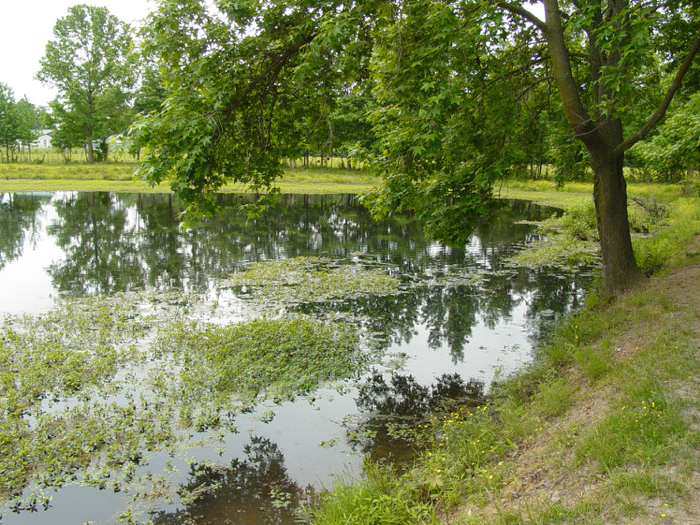Basin Considerations
Shorelines
Banks should be moderately sloped until reaching a water depth of 3 feet near the shoreline to eliminate shallow water areas around the pond edge where aquatic plants often start. Use a 3:1 slope where possible (the depth increases 1 foot for every 3 feet away from shore) until reaching the minimum depth. In other words, when you are standing in the pond 9 feet from shore, the water should be 3 feet deep.

Cattle may cause bank erosion and muddy water. Fence the pond to limit or prevent damage by livestock. Watering troughs can be placed in ways that use pond water for cattle without allowing animals to enter the pond.
Pond Bottom
Many potential pond sites have trees in the basin, most of which should be cut and salvaged or piled and burned. It is acceptable to leave some trees, bushes, and brush piles. During construction, decide which trees to leave, clear unwanted trees, and develop fish attractors. Such underwater cover is attractive to fish and provides habitat for certain aquatic organisms that fish eat. Be sure you can find these areas after they are flooded.
Usually 10 to 15 percent of the pond bottom should have some tree cover (fish attractors) where possible. It is important to leave tree cover in the right areas. Leave bushes and trees in deeper water areas, along creek runs, and in the middle of the pond or lake.
Leave trees in small clumps. Cut standing trees about 2 feet above the normal water level, and anchor brushy tops to the base of the tall stumps. These stumps will serve as permanent markers to brush top locations and avoid the dangers of falling limbs in later years.
Do not leave trees or bushes in shallow areas, narrow coves, or along the bank, because these areas will become difficult to fish and may develop aquatic vegetation problems. Too much cover in shallow water makes it hard for bass to feed on the bream. You should be able to navigate the entire shoreline by boat.
Use excess earth from construction to make underwater contours, piers, channels, and islands. Before flooding, prepare gravel fish spawning beds, build wooden and/or earthen piers, and make any other structural items.
Prior to filling, make sure you have finished all in-pond efforts. If a soil test determines that lime is needed, apply lime to the pond bottom while dry. Plant wheat, rye, millet, or other suitable grasses in the pond bottom to produce lots of aquatic life when the pond is filled. Creating a plant cover will reduce erosion and siltation that can cause muddy water.


